A person is always guaranteed a tasty time when visiting Montreal.
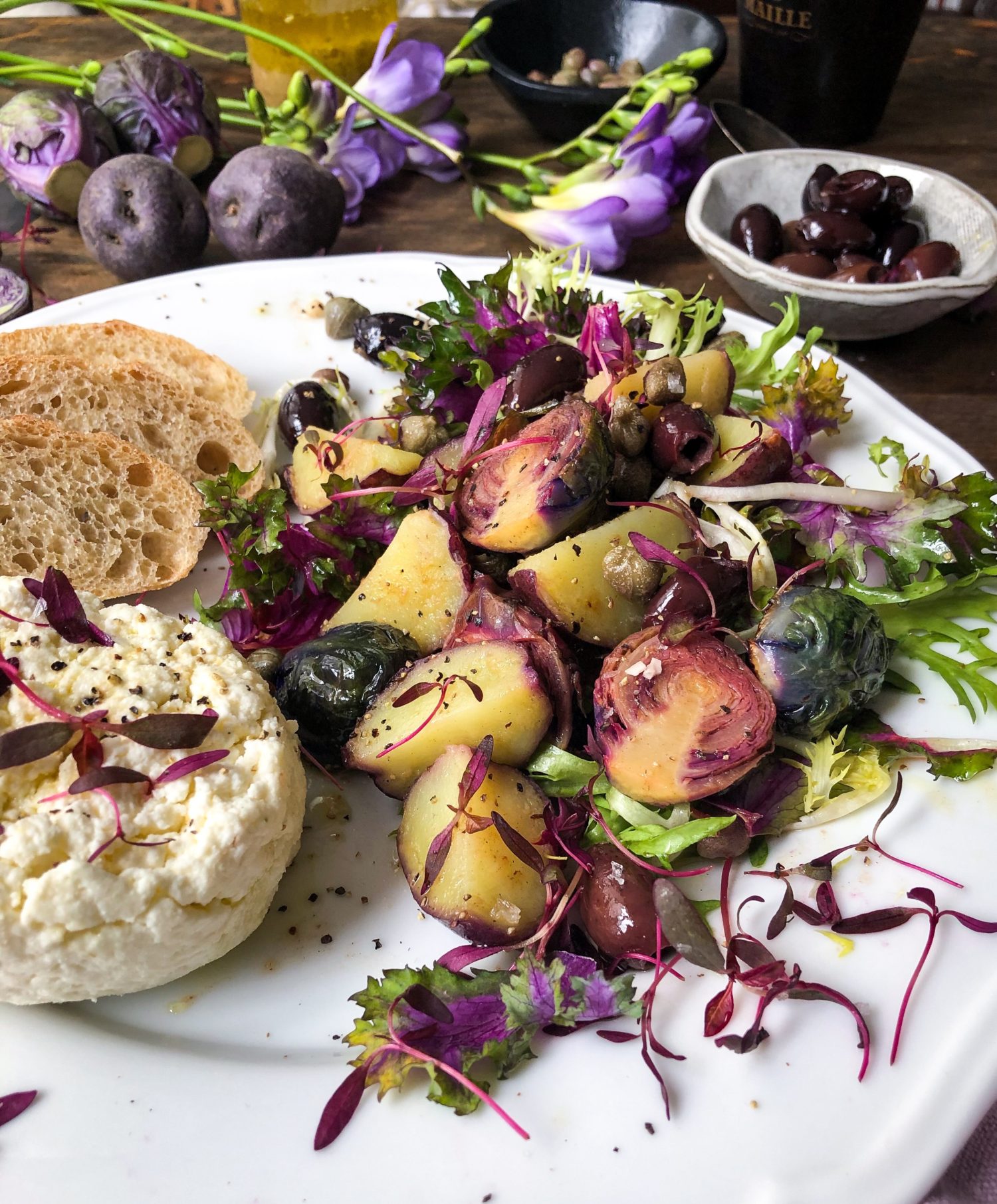 This post has been sponsored by Half Your Plate Canada.
This post has been sponsored by Half Your Plate Canada.
My latest visit to Montreal was no exception. Along with exploring Old Montreal and popping into some favourite eateries, I had the pleasure of attending the Canadian Produce Marketing Association’s annual trade show and conference. It was several days of being surrounded by fresh fruit and veg, and the farmers and suppliers who make them accessible to all of us here in Canada. Thanks to both Food Bloggers of Canada and ‘Half Your Plate’, a campaign which works hard in promoting a healthy lifestyle through diet, I was able to be part of the event this year. They are driving forces to carry this important message, and ones that I am happy to support. In their own words, Half Your Plate states:
The Canadian Produce and Marketing Association, the Heart and Stroke Foundation, Canadian Public Health Association, and the Canadian Cancer Society continue a long-standing partnership to improve fruit and veggie consumption in Canada. These organizations, widely respected for their role in health promotion and disease prevention through healthy eating education, proudly support the Half Your Plate campaign.
The success of Half Your Plate hinges on a team-effort, including a network of Public Health practitioners, all sectors of the produce industry, media and more – to spread the word to all Canadians about the role fruits and veggies play in a healthy lifestyle.
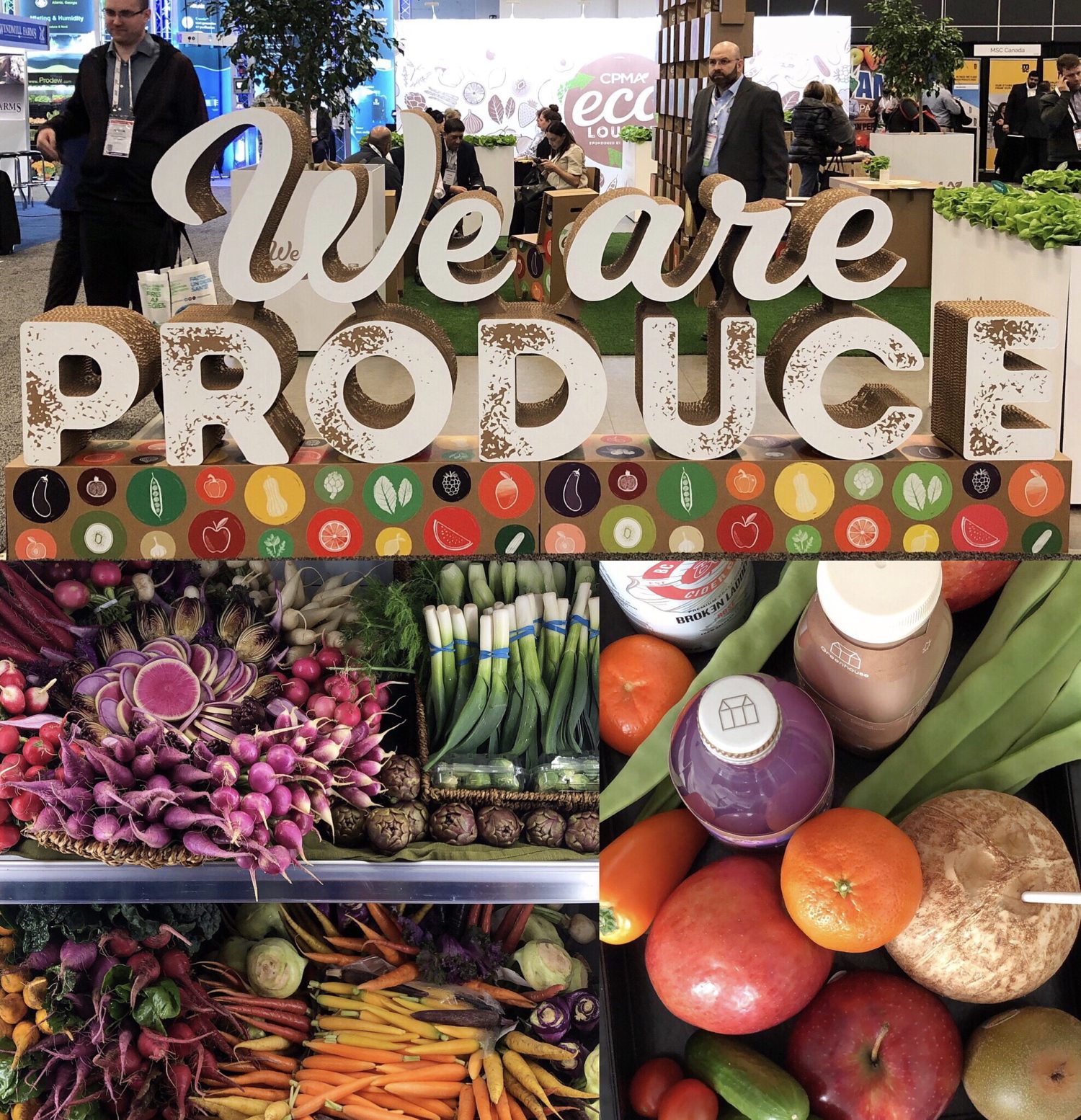
Naturally, I ate well. We enjoyed a great meal of sharing plates at Restaurant Cho, a funky restaurant specializing in Asian Fusion tapas with a Quebecois twist! Yes, it sounds wild and it’s fabulous. The kimchi cucumber, and fried cauliflower with gruyere were personal faves. Our hotel was right by Old Montreal, so I wandered the cobblestone streets, popping into the shops contained in the old buildings dating back to the 1600’s. Truly, if you want a taste of Europe, but a plane trip across the ocean isn’t in your plans, pop on over to Montreal or Quebec City, and you will feel transported in place and time. I couldn’t let a visit to Old Montreal pass without a visit to the classic patisserie Maison Christian Faure for a cannelé, and of course Olive et Gourmando never disappoints for something healthy and tasty for breakfast or lunch, but more on that later.
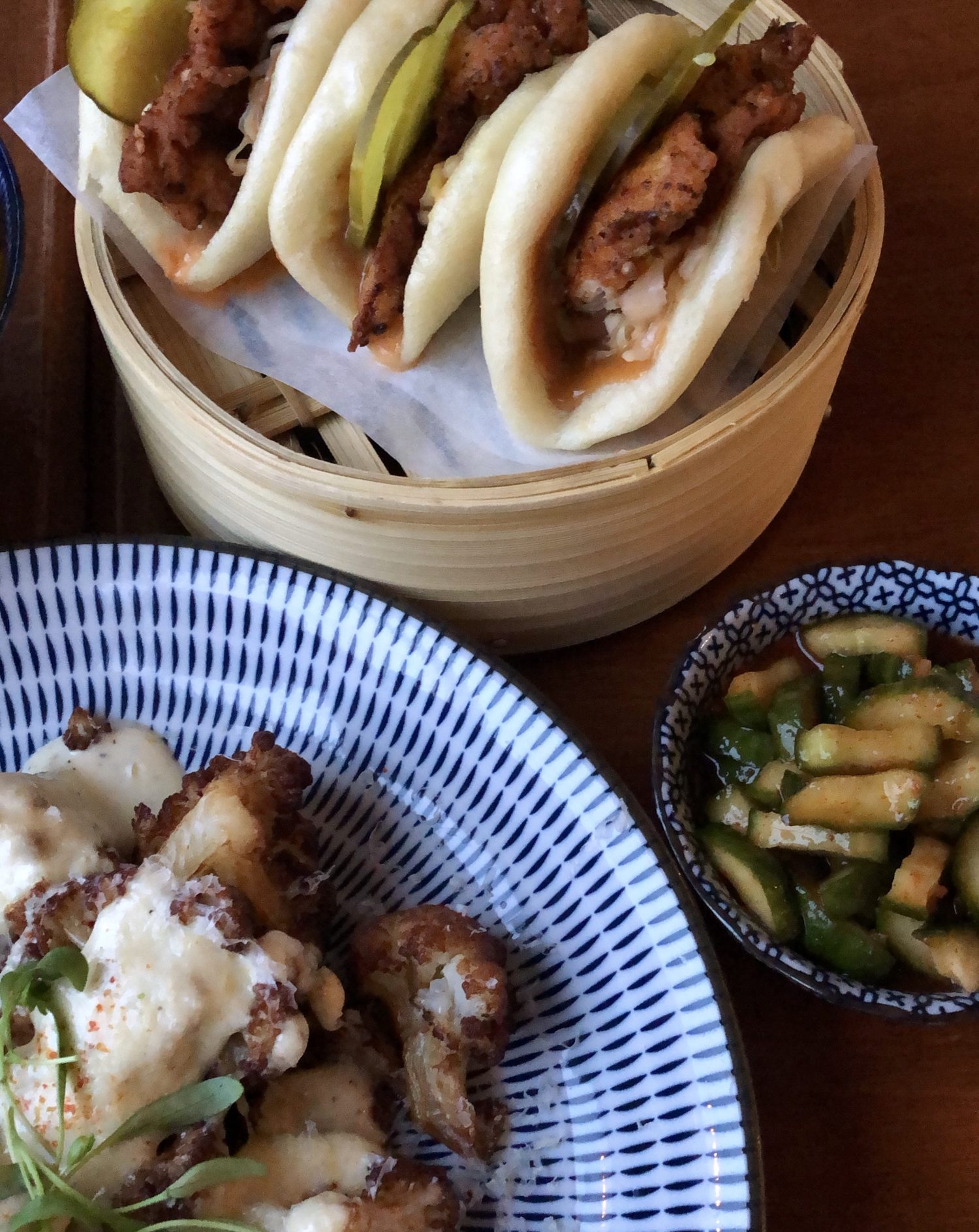
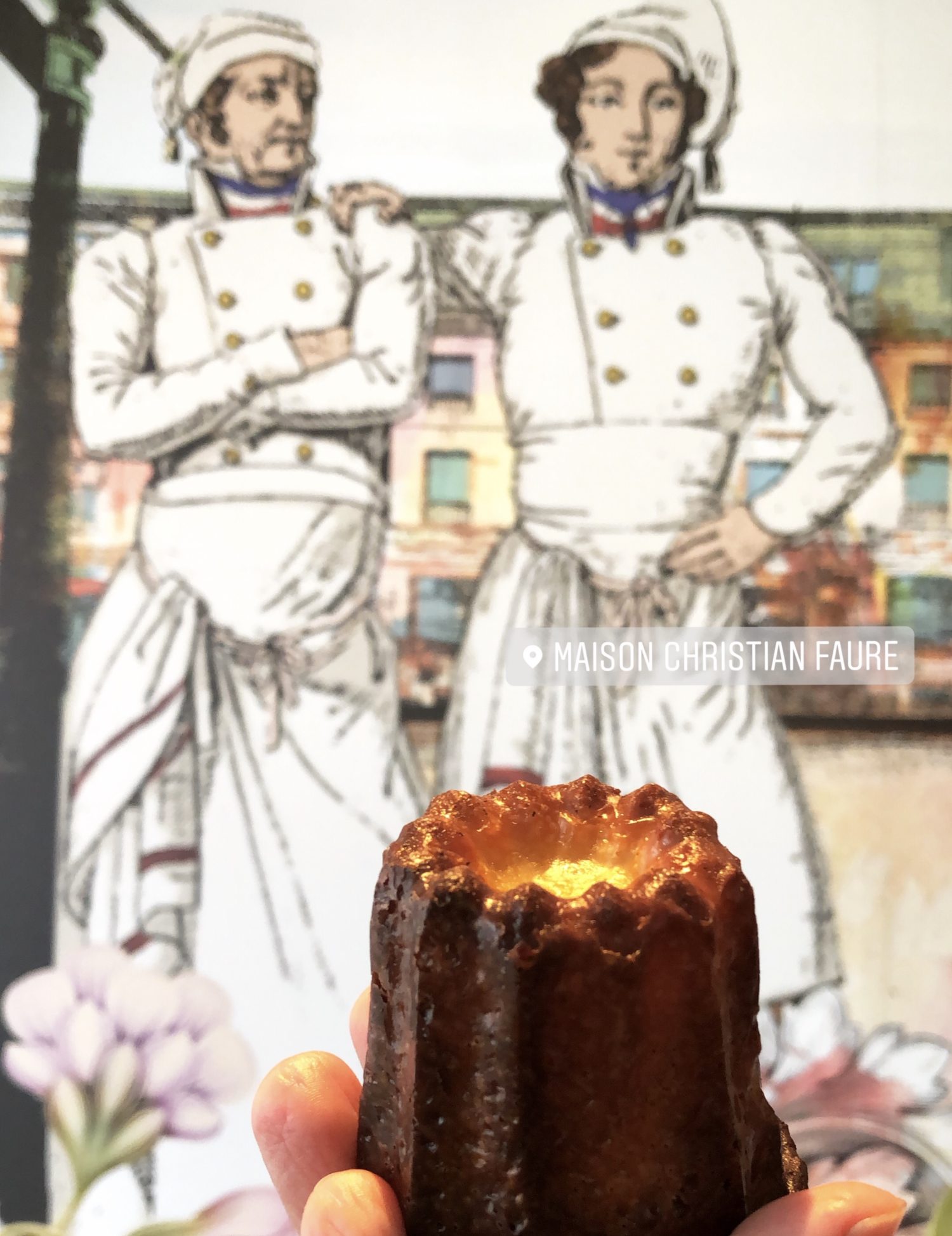
We were also fed well as we visited all the various farmers and venders at the conference- all that fresh fruit and veg, coming from as far as Belgium, the Middle East and all over Central and South America! And I learned a lot along the way. Sustainability, food waste, plastics in the water system, these were all topics addressed, seeing that they are on the minds of farmers, suppliers and consumers alike. So it was refreshing to see how suppliers are taking these messages to heart with inspired new packaging. More compostable materials for labels and containers, less plastic, innovative techniques for farming and transport, etc. We even got to view a great method for vertical farming at the DelFresco display, with their Living Cube.
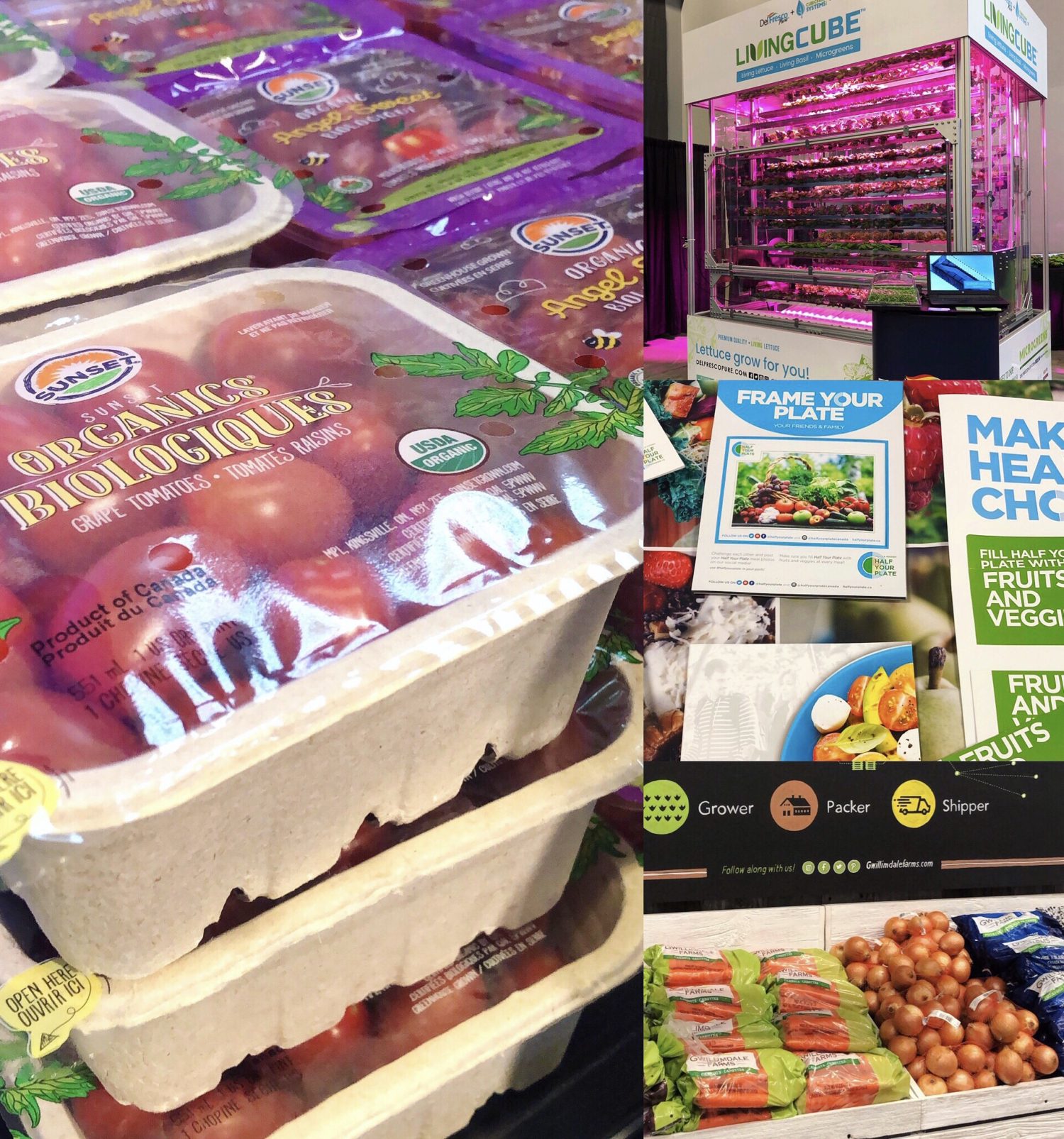
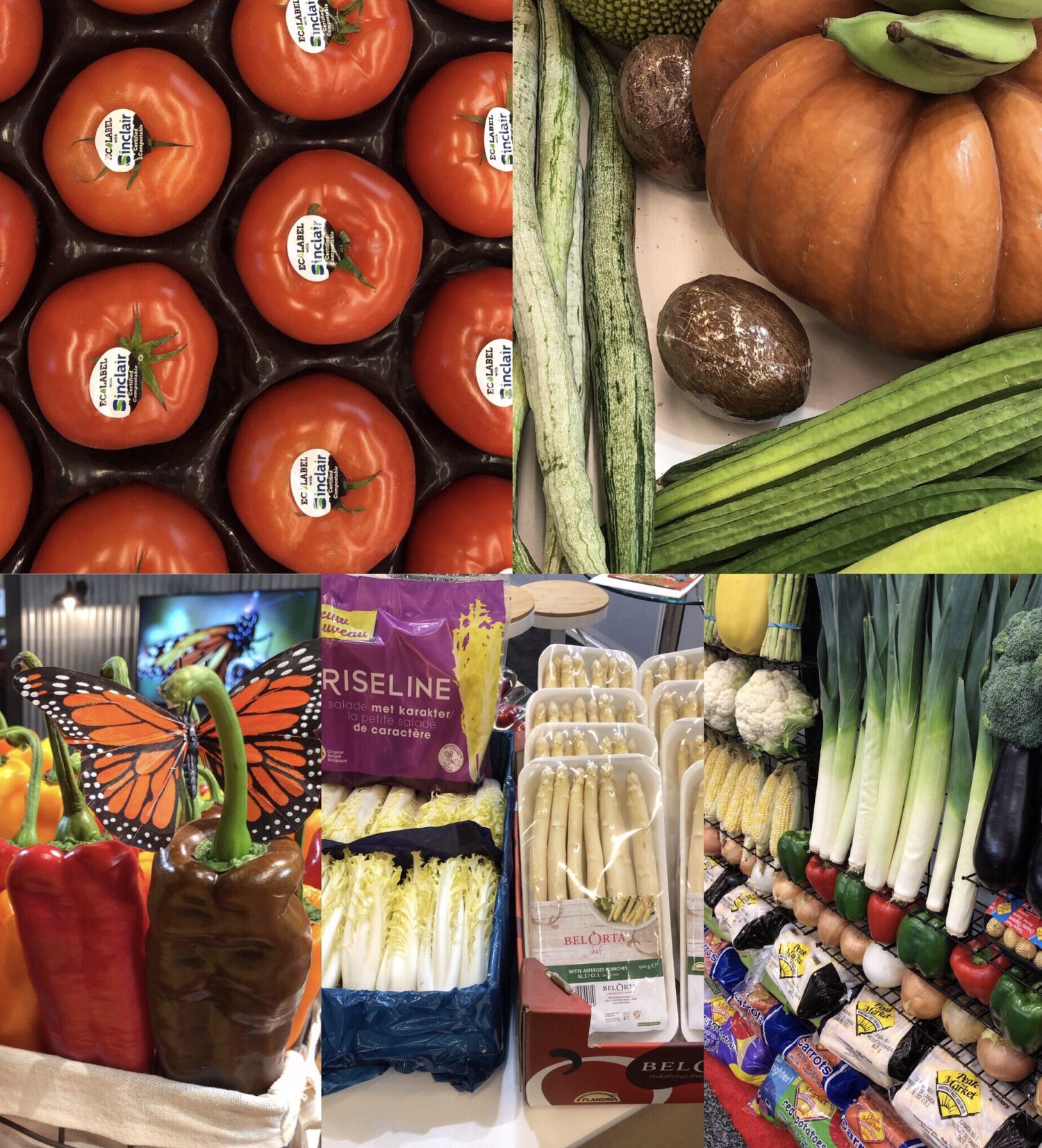
A game changing moment occurred when I chatted with one supplier from Belgium, who was distressed when he heard how much food waste happens in North America. “Is it really 40%?” he asked me, with a concerned look on his face. I had to think a minute before admitting that it was, and not just at the institutional, retail or restaurant level. The average consumer definitely contributes to the statistic. “But why?” he asked. While I couldn’t give him a definitive reason, I had to reflect on my own shopping habits. Going into a Whole Foods type of environment, where the bounteous displays and cornucopia of options are the standard, we are really just bombarded with too many options. Everything looks so good, that it is understandable that we want to bring a little bit of everything home. And these grocery stores have this self-imposed standard of ensuring that the displays are always completely full, enticing shoppers to want to sample everything. But by doing so, there will be waste. Not everything will be purchased, and so there is waste at the store level, when they have to discard the un-purchased to make room for the fresh new produce. Unlike Europe, where grocery stores will just not keep filling the broccoli or cucumber sections. Once the vegetables are purchased, that’s it for the day, you’ll have to purchase something else. North America has really encouraged the retailer to put purchasing ahead of the responsibility of food waste.
So how do we combat this at our level, as the average consumer? I had to give this some serious thought in my hotel room that evening. What do I do to contribute to the food waste statistic? And I had to admit, I do sometimes purchase more than we need for that week. I get giddy when I see a new season of rhubarb, or asparagus or strawberries etc hitting our local markets. There is nothing wrong with that. But do I really need it all then and there? Can I go one week without having everything at my disposal in the fridge? So here are some of my tips for reducing unnecessary food waste at home. I’m sure we could think up more, if we all put our heads together!
How to counteract this food waste dilema:
- Before going grocery shopping, shop your freezer. Is there some chicken in the freezer? Pull it out. Is there some forgotten bolognese sauce in some tupperware underneath the frozen fruit for your smoothie? Pull it out. In fact, a food blogger friend suggests having a plate in your fridge dedicated to thawing something from your freezer at all times. This will force you to use what you loved enough to freeze in the first place.
- Shop the fridge. Is there some zucchini in the crisper? Use it. Create some fabulous salads with all the bits and bobs before heading out to purchase more, which will just force those perfectly acceptable veggies to the back of the fridge. Make a soup. Throw less than beautiful fruit into a smoothie or oatmeal bowl.
- Use the Best Before date with some common sense. Is sour cream suddenly bad the day after the ‘best before’ date printed on the lid? Doubt it. That yogurt probably has a couple of days left as well. Now, I’m not encouraging you to eat rancid meat or sour milk, but don’t be in a haste to throw something out, just because of a printed date. Those are recommendations, of course. But be reasonable.
- Take inventory. Do you already have two half used jars of mustard open? Then don’t buy a third one. Even if it is a different flavour that you want. If you are making a salad dressing and run out of dijon, guess what, French’s Prepared Mustard (the bright yellow one!) will work just fine!
- When making your grocery list, check the fridge and pantry first. You may actually have some mayo unopened in the cupboard already.
- And speaking of lists, make a meal plan for the week, using what is already on hand, and only purchasing what is needed to finish out the week’s meals. I definitely try to do this. And guess what, I still probably anticipate making more than I actually do make. Suddenly the meal I was planning to make on a Wednesday won’t happen when I get a last minute call from Jim saying that his schedule has changed. So I don’t make that big meal that night after all. Now I have one extra whole meal’s worth of groceries left over. Surely this happens to everyone at times. So I plan for one LESS meal than needed. And if I do need more food, there is always eggs!
- And finally, take that list with you, and shop only from it! If you know that there may be a new veg or fruit hitting the market, include it as a wild card, but not as a bonus purchase.
Being surrounded by all the amazing inspiration at the conference, it isn’t hard to want to live the ‘Half Your Plate’ standard. To see bright and cheerful fruit and veg filling most of our plates and bowls is such a mood booster, let alone a boost to our digestive and immune systems. Plus, colour!! When you think of it, all the best ‘Crayola’ or rainbow hued foods are what are found naturally pre-packaged by the vine, tree, or bush. Breads, grains, carbs, meats etc are really all just shades of brown, right? Not that there’s anything wrong with them, but like ‘Half Your Plate’ suggests, just don’t let those drab colours take over. Let the rainbow be the majority. And now with Canada’s new Food Guide in complete visual support, it’s like we have licence to play with all the colours we want!
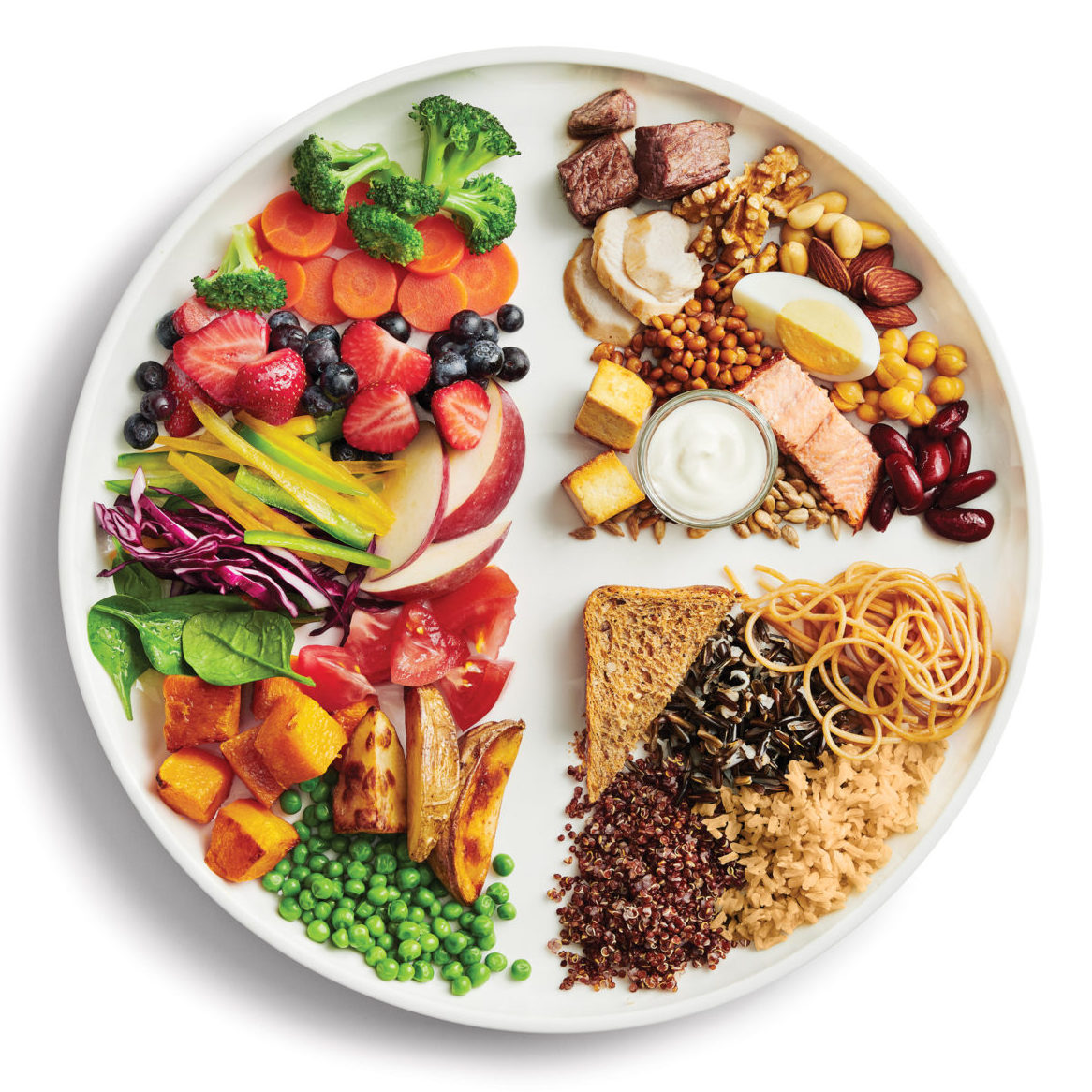
And I found the perfect recipe to showcase both Old Montreal, and everything that I gleaned along the way at the conference. Remember I mentioned that I enjoyed a meal at Olive et Gourmando? A quaint, quirky bakery/cafe right in the heart of Old Montreal. The aroma of freshly baked pastries and coffee welcome you as step in the door. And if you are in the mood for a hearty and healthy breakfast or lunch, they have so many tasty artisan options. I was totally enamoured with the ‘Salty Ricotta’ dish. Fresh homemade ricotta drizzled with olive oil and maldon salt, resting on the side of an abundant salad of micro greens, grilled pepper and fennel, topped with a lemon vinaigrette, olives and capers was the perfect lunch for me. There was some fresh homemade flat bread to spread the cheese out on, and sop up the extra dressing. And when I looked at the plate, well, wasn’t it exactly a ‘Half Your Plate’ and Canada Food Guide example!!
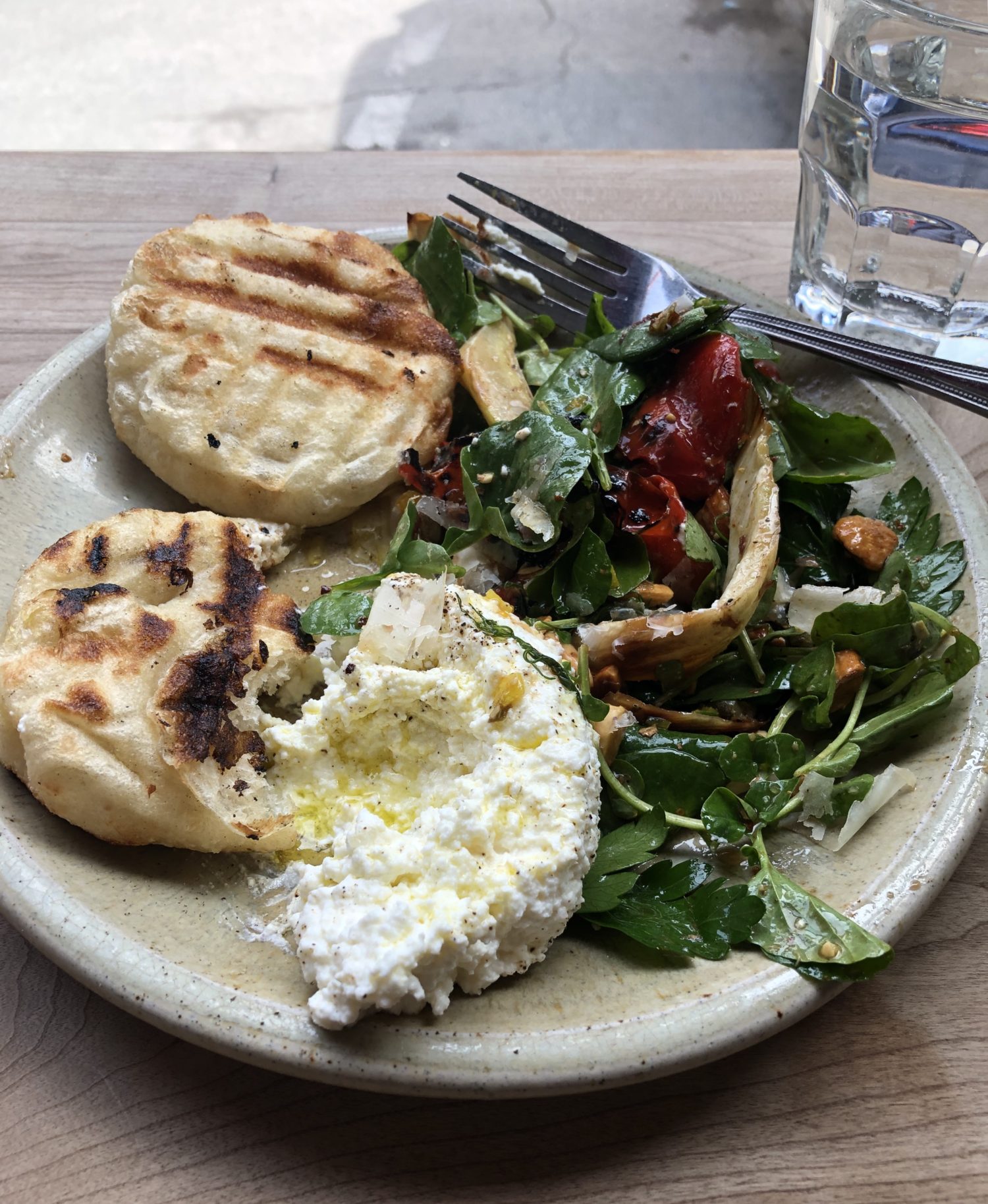
So this is the inspiration for the recipe today! I put together a Homemade Ricotta, with a grilled salad of fresh produce that I picked up on the weekend. It just so happens to have a purple theme. Because when I saw the mini purple brussels sprouts and potatoes, I just couldn’t resist. Purple flowering kale and frisée became the base, with purple kalamata olives and purple amaranth as a garnish. There’s a bright lemon and mustard vinaigrette. But you can use whatever colours happen to strike your fancy. This recipe is more of a guide than a “you must follow this to the letter for it to work” kind of recipe. Have fun, and eat your fruit and veg!!
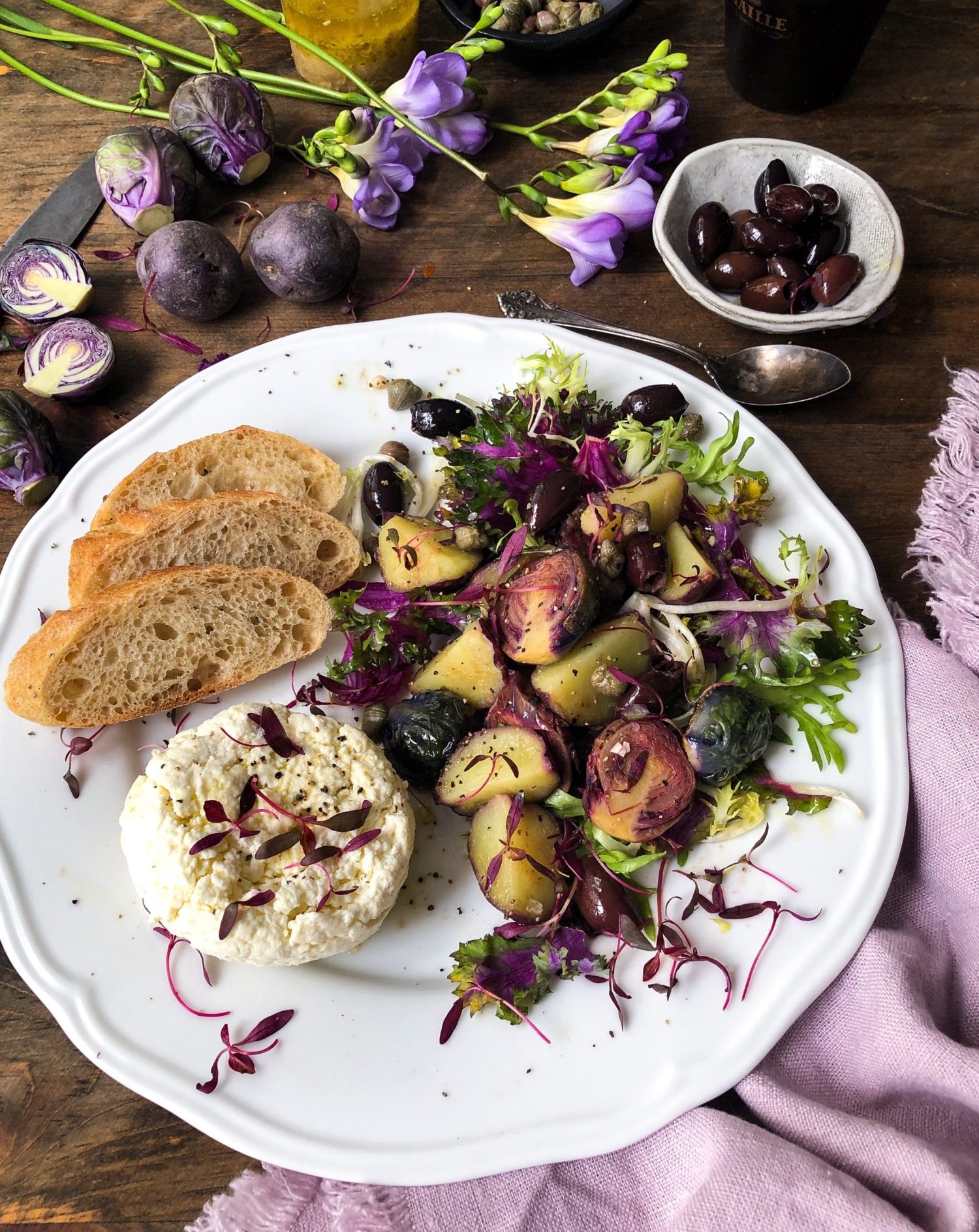
By the way, this is my go-to ricotta recipe. It’s no fail, and so versatile. It can be adapted to whatever you are needing it for. There is just enough salt added for flavour, but not so much that you can’t use it for sweet recipes. Depending on how dry and crumbly you want it, it will make around 2 cups. I recommend saving the whey, just in case you drained too much and discover the next day when you take it out of the fridge that it is more crumbly than you desire. Then you can just add some of the whey back in and give it a good stir to make it more creamy. And the whey itself is fabulous for baking or adding to smoothies! Be forwarned, I can eat this creamy, delicious ricotta with a spoon. No need to ever purchase ricotta again! I’m adding this recipe to the Pantry section of the blog, since having a good ricotta recipe is the jumping off point to so many other great recipes.
And if you have some favourite tips and tricks to reduce food waste, I would love to hear yours 🙂
Love Jen
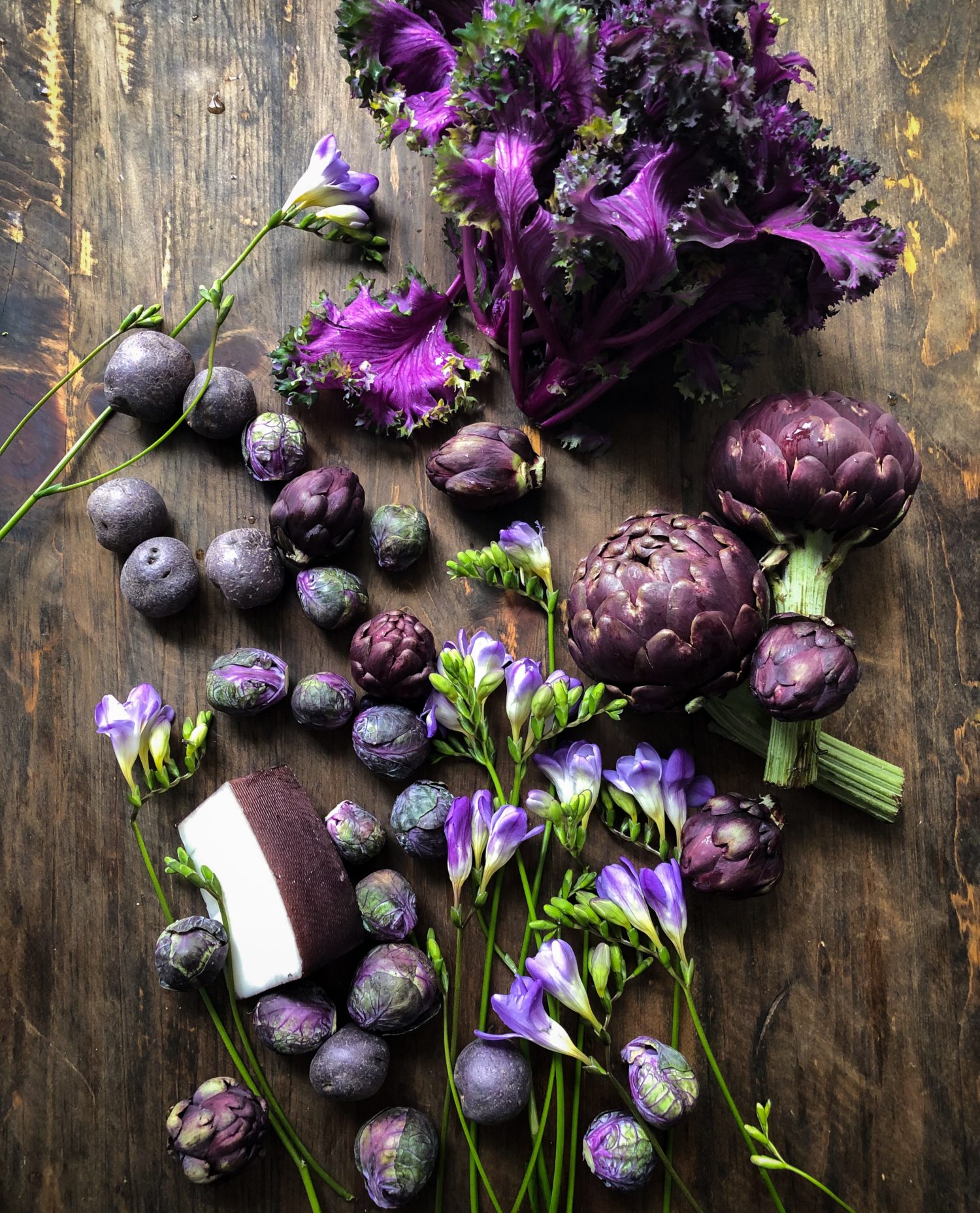
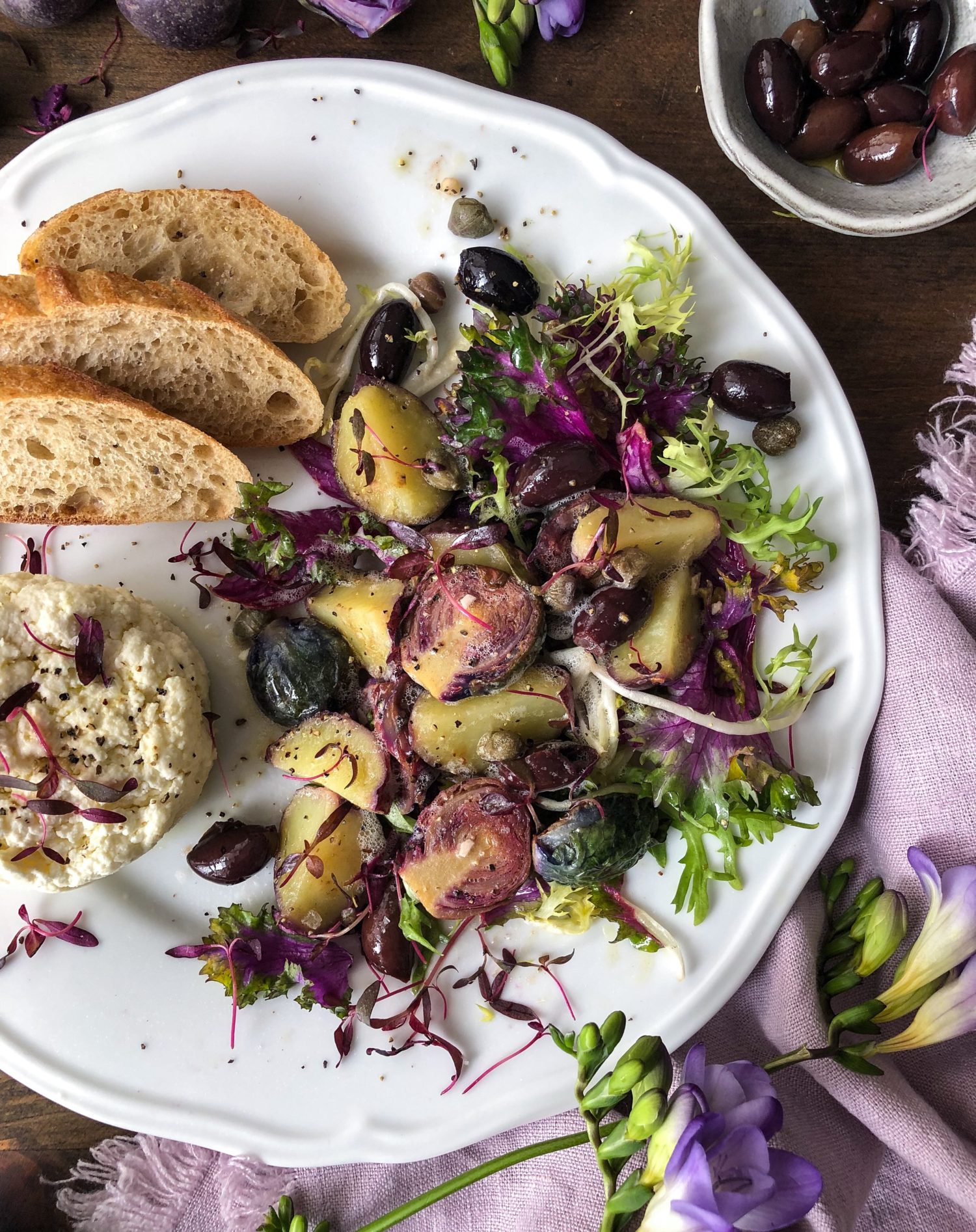
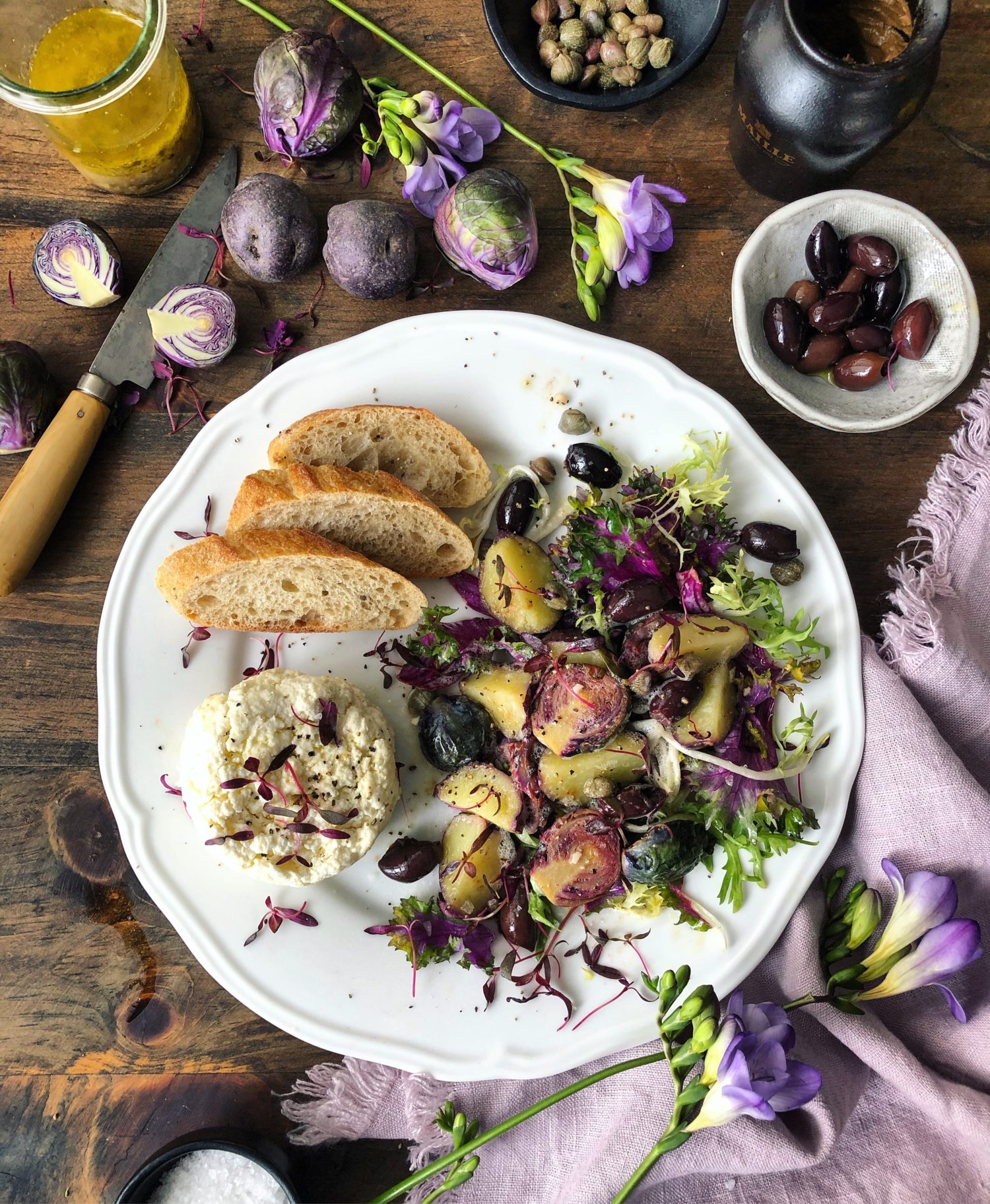
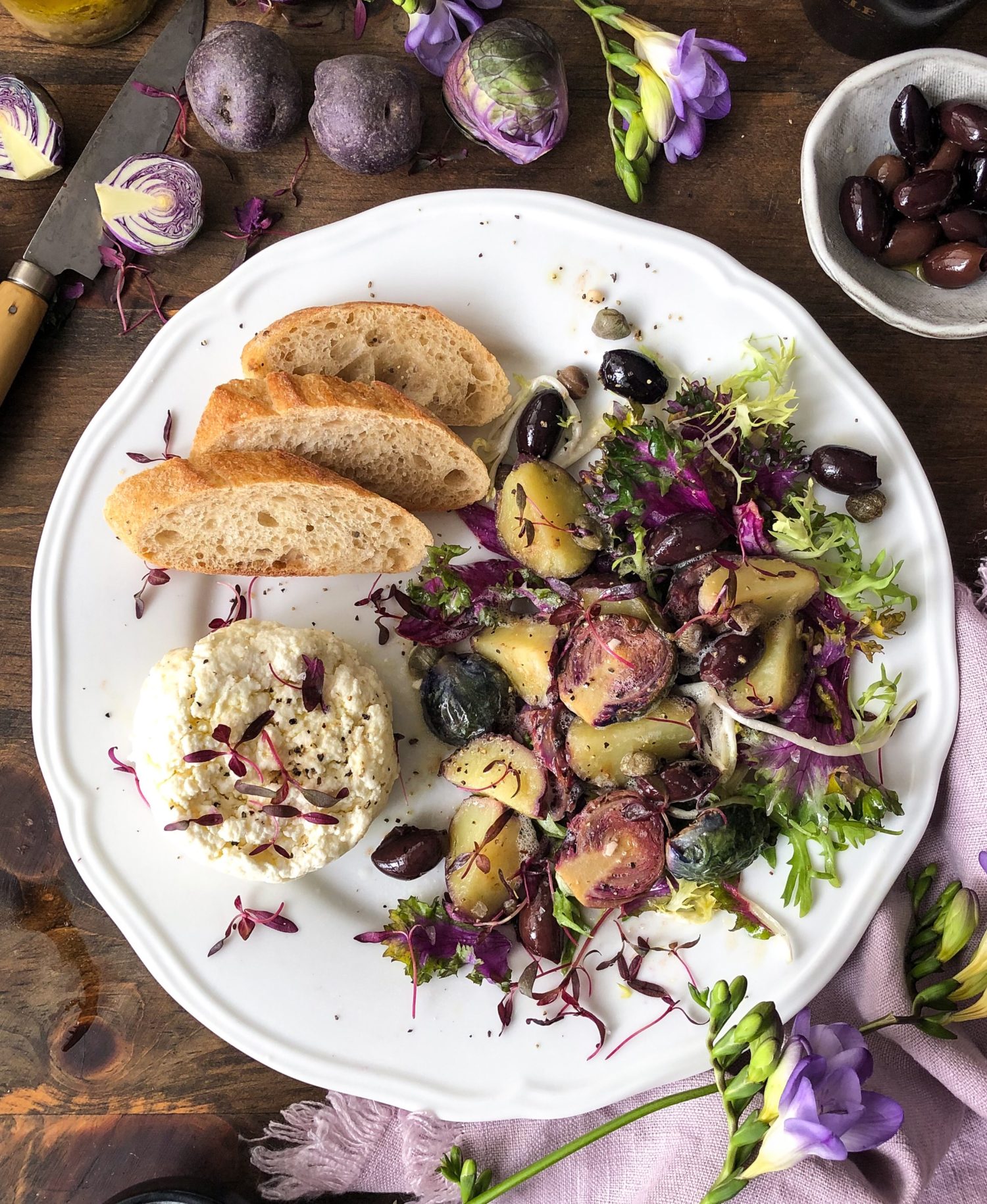
Grilled Vegetable Salad with Homemade Ricotta Cheese
Soft creamy ricotta is the side to a fabulous composed salad of greens, grilled veggies, briny olives and capers, and all topped with a bright lemon vinaigrette. A perfect springtime lunch or light dinner
Ingredients
Ricotta Cheese
- 1/2 gallon (2 quarts; 8 cups; 2 litres) whole milk, not skim or low fat.
- 1/3 cup lemon juice from 1 1/2 to 2 lemons, or 1/3 cup distilled white vinegar
- 1 teaspoon salt optional
Lemon Vinaigrette
- 4 tbsp olive oil
- 2 tbsp lemon juice
- 1/2 small shallot minced
- 1 tsp dijon mustard
- 1/4 tsp kosher salt
- 1/4 tsp cracked pepper
- 1/2 teaspoon finely grated lemon zest.
Salad
- 5-6 mini potatoes about 3 per person, depending on the size
- 6 brussels sprouts
- 2 small handfuls of fresh massaged kale arugula, romaine, baby gems, micro greens, frisée etc.
- kalamata olives
- capers
Instructions
Ricotta Cheese
-
Pour the milk into a 4-quart pot and set it over medium heat. Let it warm gradually to 200°F, monitoring the temperature with an instant read thermometer. The milk will get foamy and start to steam; remove it from heat if it starts to boil.
-
Remove the milk from heat. Pour in the lemon juice or vinegar, and the salt. Stir gently to combine.
-
Let the pot of milk sit undisturbed for 10 minutes. After this time, the milk should have separated into clumps of milky white curds and thin, watery, yellow-coloured whey — dip your slotted spoon into the mix to check. If you still see a lot of un-separated milk, add another tablespoon of lemon juice or vinegar and wait a few more minutes.
-
Set a strainer over a bowl (make sure that the strainer clears the bowl, so that the curds aren't sitting in the drained whey. If you don't have a bowl that will achieve this, then drain and transfer the whey to a different container and let the strainer sit over the bowl. Line the strainer with 2-3 layers of cheese cloth. Scoop the big curds out of the pot with a slotted spoon and transfer them to the strainer. Pour the remaining curds and the whey through the strainer. (Removing the big curds first helps keep them from splashing and making a mess as you pour.)
-
Let the ricotta drain for up to 60 minutes, depending on how wet or dry you prefer your ricotta. If the ricotta becomes too dry, you can also stir some of the whey back in before using or storing it.
-
Fresh ricotta can be used right away or refrigerated in an airtight container for up to a week. Makes about 2 cups.
-
Save the whey in a glass container in the fridge (see Notes below)
Salad Dressing
-
Combine all the ingredients in a glass jar and shake well. Taste and re-season if desired.
-
If storing in the fridge, remove from the fridge at least 30 minutes in advance to let the olive oil return to room temperature. Shake again.
Salad
-
Bring the mini potatoes to a boil in salted water and reduce to a rolling simmer and par boil for 15 minutes or until a knife can slide in without resistance. Drain and let cool. When cool, slice in half. At this point you can serve them, or you could grill or sauté them if desired.
-
Trim and halve the brussels sprouts
-
Heat a sauté pan over medium-high heat. Once hot, add 1/4 cup water and Brussels sprouts to pan; cover with a tight lid and cook for 5 minutes.
-
Add butter, a pinch each of salt and pepper to pan; cook, uncovered, 5 minutes, stirring often till they are tender and crisping up.
Alternatively you can now grill the sprouts up on a hot grill pan or bbq.
-
Plating the salad:
-
Place the potatoes and brussels sprouts in a bowl. Drizzle with a couple of spoonfuls of the dressing. Let them soak up the dressing.
-
Take all the greens and place them in a bowl. Drizzle with a spoonful of the dressing.
-
Add some olives and capers to the greens and toss.
-
Place the greens on the plates. Top with the cooked veggies.
-
Place about 1/2-3/4 cup of the ricotta per person on the side of the salad. Drizzle any remaining dressing over the ricotta and salad.
-
Serve with a side of bread for sopping up everything!
Recipe Notes
Ricotta: I like some salt in the cheese. You can even choose to use a little more, depending if you know the ricotta will only be used for savoury dishes.
Whole vs. 2% vs. Non-Fat Milk: While whole milk is the favourite for making ricotta, 2% milk can also be used, though the ricotta is slightly less rich and creamy. Avoid using skim and nonfat milks; these don't separate as easily into curds and whey.
Pasteurized Milk: Pasteurized milk is fine to use for making ricotta, but avoid UHT (Ultra High Temperature) pasteurized milk as this process changes the protein structure of the milk, preventing it from separating.
Making Fresh Ricotta Salata: If you'd like to make a fresh farmer's cheese (ricotta salata) from this ricotta, wrap it in cheese cloth and press it beneath a weighted plate in the refrigerator overnight.
Using the Leftover Whey: The leftover whey can be used in place of water in any baking recipe, whizzed into smoothies, or drunk on its own over ice.
Ricotta Recipe from The Kitchn
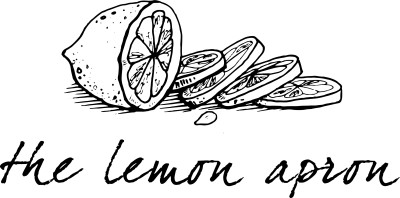
Good
Thanks 🙂
“A beautifully balanced dish that brings together the smoky depth of grilled vegetables with the creamy richness of homemade ricotta. Fresh, flavorful, and satisfying—this salad is a celebration of seasonal ingredients and simple cooking done right!”